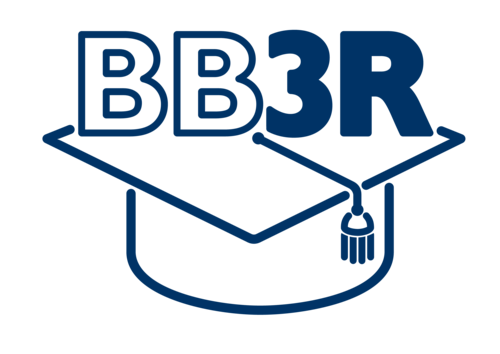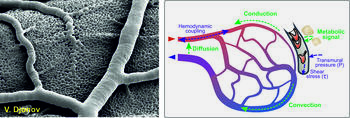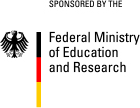PC-based Simulation in drug discovery
Emerging Angiogenesis
The focus of AG Pries at the Institute of Physiology, Charité is set, beside other topics, on the microcirculation, vascular adaptation and angiogenesis. Although the functionality of matured blood vessels is well investigated, there is only limited knowledge about the developmental processes in their early stages. To answer these questions they have chosen the chorioallantoic membrane (CAM) of a chick embryo as model, for the possibility of observing its developing blood vessels in vivo without any invasion and damage to the living system. The changes in the vessel morphology, network topology and hemodynamics are recorded during the observations. Furthermore, mature blood vessels can be seen gradually emerging from the capillary meshes (left); we call this process emerging angiogenesis. Their goal is to identify key parameters influencing this process and create a computational model (right) which will be able to create realistic networks of blood vessels as observed in the CAM.
Structural Bioinformatics
The goal of AG Preissner is to undertake bioinformatics-related research and education with emphasis on structural bioinformatics to improve the understanding of living systems. Their interdisciplinary research spans a broad range of topics in Bio/Cheminformatics and Personalized Medicine with a special emphasis on understanding of the evolution, structure, function and interaction of chemicals, proteins and disease relationships with focus on immunology and cancer. They accept the challenge to predict the results of in vitro experiments via computational modeling, simulation and screening to complement the principles of the 3Rs. They believe their models could significantly reduce the number of experiments needed to estimate chemical toxicity and assessment of toxic doses of chemicals in rodents.
In-silico Toxicology Predictions
The focus of the AG Volkamer is the development of structure-based methods to come closer to the vision of transforming toxicology into a predictive science and reducing the number of animal testing. The group strongly focuses on computer-aided prediction of off-target effects as well as the identification of novel ‘toxicophores’ and toxicity targets (targets associated with adverse drug reactions) using ligand- as well as protein-based structural and physicochemical information. Structure-based (binding site assessment and comparison, pharmacophore elucidation, structure-function relationship) and ligand-based (screening, QSAR, machine learning) methods are investigated to guide the design of more selective and less toxic compounds.
(Website under construction)
´Virtual Physiological Human´ der EU (http://www.vph-noe.eu/).


